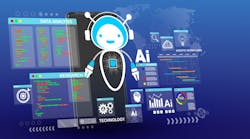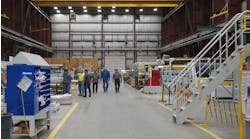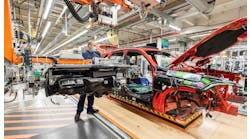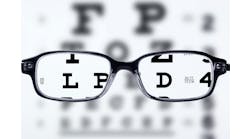How Augmented Reality Can Revolutionize Manufacturing
On factory floors or on the field — whether at a manufacturing plant, an offshore oil rig, or a field inspection of transmission equipment — the health and safety of personnel is a key requirement. With the wrong equipment, a team could be stuck lugging heavy, outdated technology, dealing with a lack of connectivity, or juggling tech that requires a free hand.
Luckily, many enterprises are exploring wearable technologies such as head-mounted devices integrated with augmented reality. Augmented reality is the fine line where virtual reality and reality meet. AR overlays virtual reality over real objects, providing all the necessary data a technician needs to make an assessment or perform a task.
It might still sound like something out of a science-fiction movie, but it’s being used in manufacturing today. Instead of trying to guess what’s wrong with a particular part, you can have the part actually show you whether it’s within tolerance and whether it’s working correctly using a combination of the Internet of Things and augmented reality. And on top of being able to build products more efficiently, smart helmets can circumvent and assist in both worker health and safety with hands-free assistance.
The device or item will not only tell you something is wrong, but will also show you what is happening (or will happen) if it isn’t repaired or replaced, making it easier for technicians to do their jobs.
Using AR Technology on the Factory Floor
Engineers at Lockheed Martin no longer need years of training before assembling F-35 aircraft. By wearing augmented reality glasses that use cameras, depth sensors, and motion sensors to overlay images onto the real working environment, engineers can see renderings of cables, bolts, parts, part numbers, and instructions on how to assemble a particular component. This new method increases engineers’ accuracy to 96%, while working 30% faster.
Microsoft HoloLens, for example, is essentially a holographic computer built into a headset that allows you to see, hear, and interact with holograms within in an environment. It enables a completely hands-free experience with gestures, voice, and holographic interaction, rendering a near real-time assistance for factory or fieldwork. And DAQRI’s Smart Helmet can render an AR display with navigation technology and live equipment visualization.
By using augmented reality, service technicians and manufacturers can walk up to any item that has IoT technology and identify an object to get any information from a company’s back-end enterprise resource planning system. As a result, he or she will immediately have access to the object’s specs, inventory, location, and lead times.
While identifying the product, AR can also give the technician access to instructions and manuals that provide operational details. While working with the object, any videos can be played immediately through the AR system. It can be used as a guide in assembly, allowing technicians to manufacture products without the need of specialized education or looking through instructional sheets. Because AR is capable of overlaying the needed part onto the part that the technician may pick up, it can allow the technician to quickly discern whether he or she has the correct part by shape and part number.
The software in AR technology can provide a visual cue to the technician where possible problems exist, as well as if there is a defect. This is helpful on the manufacturing floor when there are assembly machines that are not functioning correctly. The technician will see the actual problem even before opening up the product or machines for repairs. By allowing the object to provide a visual image via AR to the technician, it saves time and money during diagnosing and repairing. Likewise, using augmented reality technology, a technician can analyze a part that failed tolerances and determine if it is salvageable or needs to be fully replaced.
If the item is linked to the internet, it can possibly perform its own diagnostics and even report when it’s time for service or if there is something seriously wrong with it. As a result, overall customer satisfaction will improve because the item will be able to inform the service department before there is a catastrophic failure. That way, manufacturing can produce a replacement part and a technician can go out in the field to replace it before serious consequences occur.
And in the training of technicians and engineers within the manufacturing environment, AR can be collaborative and quickly enhance the participants’ knowledge with hands-on experience. For example, Bosch trained nearly 10,000 service technicians on braking and direct injection technology using its AR technology with the Oculus Rift headset. This nationwide training tour made 750 stops and provided 10-minute virtual lessons, giving employees an enhanced view of the workings of an automotive engine. And an AR session can be reproduced in a remote location for a subject matter expert when virtual co-location is enabled.
Augmented reality technology isn’t just the way of the future; it’s happening now at manufacturing facilities around the world. It gives an augmented hands-on experience that neither simulation nor reality can fully match. With AR, manufacturing companies experience cost reduction, speed increases, fewer errors, and overall improved safety. Introduce AR technology to your company now so that you gain the advantage over those still mired in conventional methods.
K.R. Sanjiv is the chief technology officer for Wipro, a global information technology, consulting, and outsourcing company. Sanjiv has more than 25 years of enterprise IT experience, including consulting, application development, and technology development spanning multiple industry segments and diverse technology areas. He holds a bachelor’s degree from the Birla Institute of Technology and Science Pilani.




